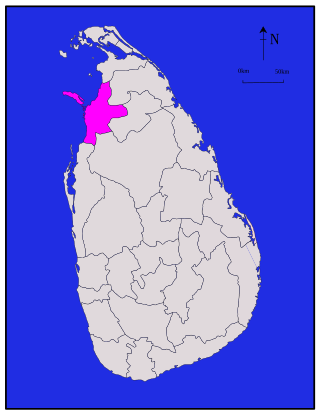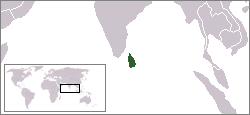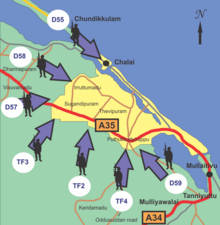
The Sri Lankan Civil War was a civil war fought in Sri Lanka from 1983 to 2009. Beginning on 23 July 1983, it was an intermittent insurgency against the government by the Velupillai Prabhakaran-led Liberation Tigers of Tamil Eelam. The LTTE fought to create an independent Tamil state called Tamil Eelam in the north-east of the island, due to the continuous discrimination and violent persecution against Sri Lankan Tamils by the Sinhalese-dominated Sri Lanka government.

The Padahuthurai bombing or Illuppaikadavai bombing happened on January 2, 2007, when the Sri Lanka Air Force bombed what they claimed to be rebel LTTE naval base in Illuppaikadavai in Northern Sri Lanka. Sri Lanka Monitoring Mission, the local Roman Catholic bishop, and the LTTE claimed 15 minority Sri Lankan Tamils, including women and children, were killed and 35 injured due to the bombing.

The Tamil Eelam Air Force or Sky Tigers was the air-wing of the Liberation Tigers of Tamil Eelam (LTTE), who used it against the Government of Sri Lanka. They also called themselves the Tamileelam Air Force (TAF). Though the existence of the Sky Tigers had been the subject of speculation for many years, the existence of the wing was only revealed after an attack in March 2007, during Eelam War IV.
Eelam War III is the name given to the third phase of armed conflict between the Sri Lankan military and the separatist Liberation Tigers of Tamil Eelam (LTTE).

Eelam War IV is the name given to the fourth phase of armed conflict between the Sri Lankan military and the separatist Liberation Tigers of Tamil Eelam (LTTE). Renewed hostilities began on the 26 July 2006, when Sri Lanka Air Force fighter jets bombed several LTTE camps around Mavil Aru anicut. The government's casus belli was that the LTTE had cut off the water supply to surrounding paddy fields in the area. Shutting down the sluice gates of the Mavil Aru on July 21 depriving the water to over 15,000 people - Sinhalese and Muslim settlers under Sri Lankan state-sponsored colonisation schemes in Trincomalee district. They were denied of water for drinking and also cultivating over 30,000 acres of paddy and other crops. The fighting resumed after a four-year ceasefire between the Government of Sri Lanka (GoSL) and LTTE. Continued fighting led to several territorial gains for the Sri Lankan Army, including the capture of Sampur, Vakarai and other parts of the east. The war took on an added dimension when the LTTE Air Tigers bombed Katunayake airbase on March 26, 2007, the first rebel air attack without external assistance in history.

The Eastern Theater of Eelam War IV, the warfare started in the Eastern province of Sri Lanka on July 21, 2006, when the LTTE cut off the water supply to the rice fields in the Mavil aru area in the eastern Trincomalee district. The government military claimed the total control of the Eastern province after capturing the Thoppigala on July 11, 2007, after nearly a year of fighting.
The Battle of Thoppigala was a battle between the Sri Lanka Army and the Liberation Tigers of Tamil Eelam (LTTE) fought during a period of the first half of 2007 over control of the LTTE-dominated peak of Thoppigala, located 40 km northwest of Batticaloa, in eastern Sri Lanka.
The Battle of Kilinochchi was a battle that occurred in September 1998 for the control of the city of Kilinochchi in Sri Lanka. The battle was fought between the Sri Lankan Army (SLA) and the Liberation Tigers of Tamil Eelam (LTTE).
The Battle of Jaffna was a battle fought from October to December 1995 for the city of Jaffna.
The Battle of Sampur was a battle fought in 2006 for the town of Sampur.
During the Sri Lankan Civil War, the Muhamalai Forward Defence Line was the Army Defence Line separating the Sri Lankan Army and Liberation Tigers of Tamil Eelam (LTTE) militia in North Central Kilinochchi from South Central Jaffna. The distance between the first line of defences ranged from 200 to 600 meters. Sri Lankan soldiers captured the 1st Forward Defence Line (FDL) between Muhamalai and Kilali at around 05:00 on 20 November 2008, pushing the LTTE lines 800m southward.
The 2008–2009 SLA Northern offensive was an armed conflict in the northern Province of Sri Lanka between the military of Sri Lanka and the separatist Liberation Tigers of Tamil Eelam (LTTE). The battle broke with the Sri Lanka Army (SLA) offensive attempting to break through the LTTE defence lines in the north of the island, aiming to conclude the country's 25-year-old civil war by military victory.

The Madhu School bus bombing, also known as Thadchanamadhu claymore attack, was the bombing of a school bus carried out on January 29, 2008, in rebel LTTE controlled area in Thadchanamadhu in Mannar, Northern province of Sri Lanka. The bombing killed 17 Tamils, including 11 school children, and injured at least 14 more people. The LTTE and NESHOR accused the Sri Lankan Army ’s deep penetration unit for the attack but the Army denied the allegations. This attack was the second attack on a civilian bus in the month of January in Sri Lanka
Operation Jayasikurui, was a Sri Lankan military operation launched on 13 May 1997, it lasted until 1999, when it was called off. The operation was initially launched for 6 months but cancelled after 18 months as Sri Lankan government faced huge loss. It was the largest military operation undertaken by the armed forces at the time.
The 57 Division is a division of the Sri Lanka Army. A principal offensive division it was deployed for combat operations in the Wanni region in 2009.
The Vanni Van bombing, also referred to as the Murukandy claymore attack, was the bombing of a private van on May 23, 2008 which killed sixteen civilians, including five children. A local Human rights organization, NESOHR alleged that the attack was carried out by the Deep Penetration Unit of the Sri Lankan army.

The Battle of Kilinochchi was a land battle fought between the Sri Lankan Military and the Liberation Tigers of Tamil Eelam (LTTE) for control of the town of Kilinochchi in the Northern Theater of Eelam War IV during the Sri Lankan civil war between November 2008 and January 2009. The town of Kilinochchi was the administrative center and de facto capital of the LTTE's proposed state of Tamil Eelam.

Madhu church shelling or Madhu church massacre is the name for the shelling of the Shrine of Our Lady of Madhu in Sri Lanka during the Sri Lankan civil war on November 20, 1999. The shelling resulted in the deaths of approximately 40 minority Sri Lankan Tamil civilians, including children, and more than 60 non-fatal injuries. The exact cause and nature of the event is disputed between the rebel Liberation Tigers of Tamil Eelam and the Sri Lankan government. According to Bishop Rayappu Joseph, the attack was carried out by the LTTE. The church is a Roman Catholic Marian shrine in Mannar district of Sri Lanka. With a history of over 400 years, this shrine acts as a center for pilgrimage and worship for Sri Lankan Catholics and others. The site is considered as the holiest Catholic shrine in the island.
The following lists notable events that took place during 2009 in Sri Lanka.







